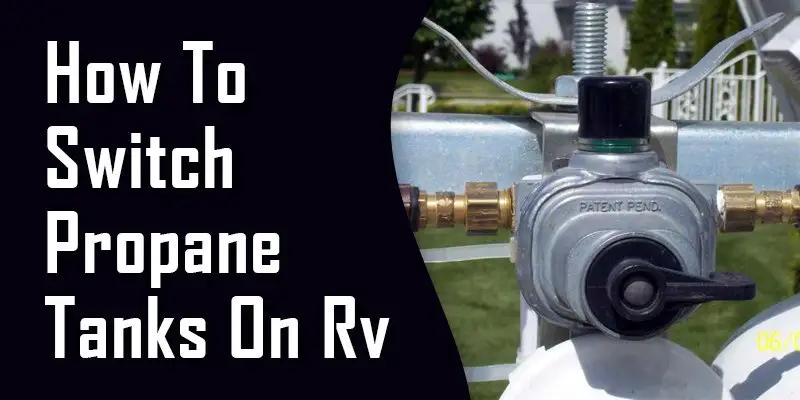How to Switch Propane Tanks on RV is a crucial thing to learn. Recreational Vehicles or in short form RV is a well-known feature of the western world. It is used for various purposes. For example, summer camping, bohemian caravans, temporary accommodation during a trip, and sometimes for people who love adventure select it as their permanent habitat.
The propane system connects you with the modern world while you travel here and there. It assures your comfort by supplying fuel for appliances. You can easily do the cooking; enjoy refrigeration, hot water for shower or heating while you are on travel. Approximately every RV has a propane system due to its convenience. Indeed rv propane tanks function as the nerve center of RV indifferently with its size and capacity.
The importance of camper propane tanks certainly implies being cautious with their usage. Therefore it is essential to learn how to switch propane tanks on RV or how to turn on propane in rv.
Flame King YSN201HZL Steel Propane Tank Cylinder
Key Features
- Built-in accurate gauge
- Overflow Protection Device Valve
- Perfect for height restraints
How to Switch Propane Tanks on RV
This work requires basic ideas about propane systems. There are two types of RVs available in general. These are Motorized or self-operated and Non-motorized or towed by another vehicle. In terms of size and purpose, there are campervans, caravans, motor homes, truck campers, fifth-wheel trailers, and so on. There are some RVs of modern days that come along with a package of electricity facility with a generator. But mostly the propane system is the basic fuel supplier for RVs.
There are two sorts of propane tanks used in RVs. These are ASME tanks and DOT cylinders. ASME tanks are mostly utilized in motor homes. This is basically installed in the frame of the vehicle itself. Thus it is not portable. DOT cylinders are inevitable equipment for truck campers, fifth wheels, and travel trailers. This cylinder is usually installed on external compartments like on the bumper or tongue of the RV. Thus it is easily removable and handy for regular uses.
The switching of propane systems is dependent on these basic features. It is not a complicated process but flammability definitely implies we take precautions before doing it. Let us describe how to switch Propane Tanks on RV.
RVs most often use one single tank or a dual automated propane system. Sometimes shifting of propane tanks could be manual as well. The operator has to use an indicator to check the fuel level of the propane tank for RVs. Nowadays almost every camper uses an automated propane system to avoid this haphazard. An automatic switchover valve reduces their pain from coming out of their warm trailers on cold nights just to check the tank gauge. You may not need to frequently check the tank gauge if it’s automated but certainly, you have to observe it for refueling and reinstall.
Step 1: Open up the Tank Cover
Pull up your tank cover. Make sure to disconnect any strap or knob that connects it with the holder. Be careful about suddenly popping out a fire or lose connections.
Step 2: Switch off Tanks
Before doing anything switch off propane tanks and make sure any power supply line is not connected with it.
Step 3: Remove Bolt, Knob, or Bracket
Generally, tanks are installed on the welded aluminum holder’s base plate. A heavy rod is situated in the center of these two tanks. The rod may contain a bracket along with a fishplate knob or spiral bolt placed on an aluminum hatch. Some may even be equipped with additional hoses or changeover switches. You may need a wrench or sometimes just with bare hands, you can remove the lock over the tank.
Step 4: Observe the Regulator
Most of the propane system contains a pigtail hose added dual propane tank regulator or single tank rv propane regulator. There is an indicating stick in the regulator that points to the active tank. The switchover valve will show the actual status of the propane on a glass fit. Red glass confirms that the active tank has become empty or non-functioning. It’s time to switch on the reserve one. On the contrary, if it shows a green one then your active tank is still providing fuel.
Step 5: Switches the Reserve Tank
At this stage, an automated propane system should shift the pointing stick to the reserve tank automatically. Then the reserve tank becomes the active tank. Similarly, the tank gauge will show the amount of reserve propane as well.
Step 6: Fill up Your Empty Tank
If you want to refuel the empty tank during the switching process, you have to follow some steps. Disconnect the empty tank from the pigtail hose of the regulator and nozzles that attach it with the holder. You can just lift up your desired tank from the holder and refill it. Notably do not refill your tanks more than 80%. During warm weather, this propane can raise vapor due to heat and this amount could be up to 95%. Thus an accident may occur at any time. So check where to fill propane tanks before going anywhere.
Step 7: Readjust the Tank
Rejoin the nozzles and hose lines of the regulator with the filled tank. Now you can select it as an active tank again or you can shift it into reserve mode. Preserving it would be a better option. Shift the pointing stick of the regulator towards the new one.
It is important to turn on both the valves of the propane tank at the time of rv propane valve operation. Some argue about turning off one to avoid any extra power loss. However, if you do so then you have to manually check and change between alternate cylinders always. Basically turning on both assures automated switchover and there is no proven evidence of extra power loss. In case you have exceptional technical problems it might happen. All you need to do is check it periodically.
Step 8: Cover the Tanks
Properly adjust straps and bolts to cover the tank. Make sure you have fixed it properly.
Flame King Dual RV Propane Tank Cylinder Rack For RVs and Trailers
Key Features
- Built From A Durable Powder Coated Steel
- Fast and Easy To Use
- Securely Holds Two 30 pounds Propane Tanks
Conclusion
How to Switch Propane Tanks on RV is inevitable if you want to enjoy the luxury of RV. The propane system is the most essential feature of the RV. Whether for summer camping, holiday tour, or simple deluxe travel, your priority is always to have a comfortable one. You can’t ignore the role of comfort, enjoyment, and hygiene that are facilitated by the propane system.
At the same time, it is also sensitive due to its high flammability. There is no alternative to learning it. You would probably don’t want to ruin your excitement of camping by thinking of fuel supply all the time. It is better you learn this basic at an early stage and spend your leisure time without anxiety.
- How to Replace Norcold Heating Element – Guideline for Easy Self Replacement
- How to Recycle Gas Cans – An Essential Guideline for Safe Recycling
- How To Lift A Camper Trailer By Multiple Techniques
- How To Get Rid Of Mouse Smell In Rv
- How To Get Rid Of Old Pop Up Camper – Easy Tips
- Pelican Vs Lifetime Kayak- The Ultimate Choice For Every Kayak Lover!
- 5 Best Kayak Carrier for Subaru Outback – Exclusive Suggestion!
- Best Sit on Top Kayak for Big Guys – Top 5 picks

